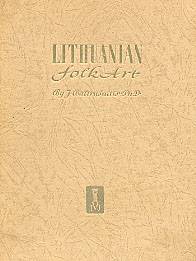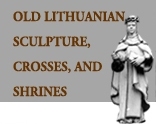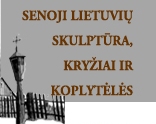BALTRUSAITIS
JURGIS: SCULPTURE
Lithuanian Folk Art.
Germany, Munich, 1948. P. 54-61
-
- The chapels and crosses shelter
small deities, the "ciieviikai" and "rupintojeliai".
The Holy Virgins and the Christs, as well as the good popular
Saints, take up their quarters under trees, appear in the
"cages",
 hung in trees, conceal themselves in the "cabins". It is
perhaps in this imagery in wood that the Lithuanian peasant has
done his utmost. A religious art, though not an art of the church,
this sculpture spread in spite of the periodical campaigns of the
clergy. One inconoclastical crusade follows another, but the work
of the ''God makers", the "dievdirbis",
does not cease. As late as in 1752 the bishop Tiskevicius of
Zemaitija preached against this statuary. No doubt he invoked the
same reasons as St. Bernhard in his fight against the monsters of
the Romanesque churches, excessive freedom of expression and
rudeness of features. Such figures were denied benediction and
their admission to sanctuaries was forbidden with only two
exceptions, a crucifixion and a Christ. All the others populate
the fields, the woods and the roads.
hung in trees, conceal themselves in the "cabins". It is
perhaps in this imagery in wood that the Lithuanian peasant has
done his utmost. A religious art, though not an art of the church,
this sculpture spread in spite of the periodical campaigns of the
clergy. One inconoclastical crusade follows another, but the work
of the ''God makers", the "dievdirbis",
does not cease. As late as in 1752 the bishop Tiskevicius of
Zemaitija preached against this statuary. No doubt he invoked the
same reasons as St. Bernhard in his fight against the monsters of
the Romanesque churches, excessive freedom of expression and
rudeness of features. Such figures were denied benediction and
their admission to sanctuaries was forbidden with only two
exceptions, a crucifixion and a Christ. All the others populate
the fields, the woods and the roads.
- Such conflicts have had a profound
repercussion on the formation of this art. Driven out of the
church popular sculpture cast off the fetters of convention and
developed itself freely. The subjects most frequently treated were
borrowed from the Gospels and the Apocrypha, as well as from the
legend of the Saints. The chief subject taken over from the Gospel
was the cycle of the Passion: Pieta, the Virgin of the Seven
Sorrows, Christ in a sitting posture or bearing the cross, the
Crucifixion. The Pi'eta remained faithful to its canonical image,
as in Western sculpture the Holy Virgin was
represented with the body of her Son on her knees. The figure of
the Savior is sometimes quite small in comparison with that of his
mother, - he always has remained a child. The Virgin of the Seven
Sorrows shows an immense heart pierced by seven flaming swords The
sitting Christ is represented as awaiting
execution.
- The Apocrypha furnished scenes from
the education of the Virgin and St. Joseph rocking the Holy
Infant. Among the Saints St. George killing the Dragon takes first
place, being the patron Saint of the Lithuanian peasant. Then
follows St. Isidore, patron Saint of the agricultural laborer with
the angel a
the plough. The iconography is in general correct. St. Catherine
holds the wheel, St. Agatha the bread, St. John Nepomuk a crucifix
and a branch. St. Rochus the pilgrim, followed by his dog, covers
his crushed leg, St. Francis receives the stygmata. Nevertheless,
certain details sound a particular note, the image of Pieta is
often blended with that of the Virgin of the Seven Sorrows and an
aureole of stars surrounds the Mother of God, while two angels
bearing chandeliers stand on each side. Sometimes she is
represented with the crown of the Grand Dukes of Lithuania on her
head. The sitting Christ, generally represented alone in Western
sculpture, is here attended by two hieratic worshipping figures.
According to Zemaitic legend this is not a scene of the Passion,
but represents Christ returned to earth after his resurrection. He
is resting by the wayside and weeping over the misery of mankind.
The Christ of Nazareth has a thick growth of hair, - a
reminiscence of a much venerated statue brought from Italy to
Vilnius in 1700, - on which the hair was believed to have grown by
a miracle. St. Rochus and St. Isidore, having arrived from abroad,
wear bowler hats. St. Francis sometimes has a large spoon stuck in
his belt. The bread of St. Agatha protects against fire. In case
of fire, consecrated bread is carried around the house. St. George
is often represented wearing a helmet. It would be easy to
multiply these examples.
- It was not however these picturesque
details which filled the representatives of the church with
indignation, but much rather the form, the movement and the
treatment of the subject. Certain figures remind us of the images
of Greece of Homer. A rudely shaped trunk has a simple sphere for
a head. On other faces a smile of Kozee is frozen. The canon is
often irregular, heads either too big or too
small, hands sometimes enormous and sometimes atrophied, postures
convulsed. It is here in these deformed bodies that the artist
gives the measure of his power of expression. Certain heads, e. g.
that of the sitting Christ submerged in the mass of his hair, his
cheeks stained by gigantic drops of blood, or that of the
crucified Christ displaying His large hands, His mouth like an
open wound. His eyes scarcely visible produce a dramatically
violent impression. The features of such heads differ widely.
Sometimes the heads are supported by long, thin necks, sometimes
they are fixed immediately on the trunk with eyes wide open or
closed and the mouths distorted in grimace, they arc supernatural
and yet true. Other figures stiffen in inaccessible gravity like
that flat and pale Virgin holding her dead son with the gestures
of an automaton. These figures however belong to two races: at the
side of a tormented and
monstrous mankind, we see a pastoral and peaceful mankind. There
the Saints are peasants, round - cheeked with salient cheekbones and
big astonished eyes. This is a homely world. The Pieta is no
longer an insensible idol, but a peasant woman who is bending over
her son. She is surrounded snot by angels, but by winged
choirboys. Often she looks like a timid shepherdess hidden behind
a fan formed of swords. Such statues are full of good nature and
joviality and they are perhaps still more pathetic than the
supernatural beings with their exaggerated features. The episodes
there are not scenes of family life, an atmosphere of mystery
still persists. The little angel, who, with courageous hands,
seizes the handle of the plough, resembles a troll in a fairytale.
The tale is often told with an epic simplicity and love of detail
does not affect the great lines. Quizzical observations assume a
new meaning. A miracle performed by a Saint dressed like a village
curate, seems to be all the more marvelous. Provided with symbolic
attributes such as bread, tools- etc. these peasants with the
resigned features of the wise and the humble ones, are given the
wings of angels and enter into legend.
- Such are the principal aspects of
this sculpture. At the same time deities and toys, reality and
fable, but seldom indifferent, these little statuettes carved in
wood affect or terrify us. The reason of the hostility of
the clergy in the era of Classicism and afterwards, when
countryside churches favored mass production of statues is easily
comprehensible.
- The composition and execution of
these statues are very varied. We find there all the stages of an
evolution, which extends from archaism to sophisticated
refinement. Forms preserved in the rites of craftsmanship, though
wide apart in time, meet again on the same object and are applied
in the
same workshop. Rigorous geometry, monumental distribution of the
masses and the ccolorful play of agitated surfaces contradict and
complete each other.
- Hard and vigorous blows hew these
statues. Synthetic lines simplify the features and sometimes
deform them. Details are accentuated by graphic incisions, the
polychromy of pure and vivacious colors emphasizes the outlines
and plans. A deep sense of architecture is everywhere manifested.
Certain extended bodies stiffen into pillars. The legs of a
sitting Pieta form a pedestal for the body of Christ. These
statues are great in spite of their reduced scale. The wood in
them is ino longer a senseless material, it helps to animate the
features represented. Within the statues the tree trunk is still
alive. The priest's vestments resemble a suit made of the bark of
a tree. St. George's dragon seems to twist and
turn like a tortuous root. These are indeed sylvan deities hewn
from a log of wood. Rigidity sometimes disappears to give place to
a more flexible treatment. The graphics of the outlines are
softened. The masses flow freely in a ripple of lights and shades,
a breeze passes over the folded clothing and the outlines
sometimes assume an affected grace. In his eagerness to make use
of anything he can, the sculptor seeks to exhaust all
possibilities and takes his inspiration from every quarter. In his
art
we find traces of the Western Middle Ages, of the Baroque and even
of the rustic toys of the present time. Lost in a world far
removed from the highways of history, the village sculptor is
often in arrear and sometimes-successive epochs and fashions reach
him simultaneously. Styles which would exclude^each other
elsewhere meet here. These different contributions arriving
simultaneously enrich his choice. But, though a recipient for
different techniques and various styles, the sculptor still
remains true to himself. He transposes and adapts without
betraying his true personality.
- The influence of toys is particulary
noticeable in groups the units of which are placed side by side
like tin soldiers without any common action to link them together.
They are displaced or interchanged, although they are incapable of
motion. Such groups of articulated dolls are nevertheless touching
in their candor. This series comprises a number of animals; St.
George's horse is often a fine pied wooden mount. The two oxen
fixed to a board and placed before a plough look like gingerbread
beasts. Led by
an angel they become God's own beasts. The magic objects of the
little ones serve for the worship of the adults.
- Among the Western styles, which have
exercised the strongest and most lasting influence in this field,
the baroque elements and classic art should be mentioned in the
first place. Following the Counter Reformation the Jesuits
triumphed over all the numerous currents of art in Lithuania. The
great European currents penetrated everywhere. Five large
religious colleges were established between 1565 and 1575, the
largest at Vilnius in 1579. There the latest doctrines were taught
and tastes refined. A new age of civilization began, cathedrals
and palaces were built and foreign masters called upon to
co-operate. Collections were brought together by the nobility and
in the churches. Certain miracle performing statues are still
venerated. But the influence of this sculpture is limited chiefly
to the
propagation of a certain number of iconographic types and plastic
themes.
The carver in wood is not insensible to this statuary, but his
work, although inspired by it, lacks its magnificence. The faces
are heavier, the gestures are awkward, the proportions become
impersonal. The agitated folds and mystic rays have perhaps been
assimilated best. But even amid all these luxuriant undulations
certain traits seem to be reminiscent of the flamboyant style.
There seems to be no doubt that medieval art has exercised the
stronger influence. This becomes evident in the very choice of the
themes, such as the Passion, the Pieta, the Holy Virgin of the
Seven Sorrows, afflicted Christ and in the preference shown for
scenes of the childhood of Christ or of the education of St. Mary,
in the success of some Saints, such as St. Rochus, the protector
against the plague. The cycle
of 15th and 16th century subjects is reconstituted. In it we find
also the figure of the Devil, with his bat wings, his horns and
crooked claws, the demon of Zemaitija hails from the hell of the
Middle Ages which classic art did not retain.
- This is a strange survival of a vast
ancient repertoire. Nothing interfered with its development. In
the churches of the towns hardly any traces of it are at present
to be found, but the chapels nailed to the trees or built at the
roadside are full of such images. They preserve it as a kind of
relic of the first Christians in this country. The witnesses of
their baptism have never abandoned the Lithuanians.
- We know that the religion of the
West was introduced at the exact time when this sculpture
flourished. The conversion of certain chieftains, such as
Mindaugas in 1251 and Gediminas in 1320, did not affect the
beliefs of the people. Only in the 15th century the penetration of
Christendom became deeper and broader. At first it had to adapt
itself to local traditions, to allow it to be mixed with local
legends, later transforming and renewing the ancient faith. No
doubt the wooden Gothic Saints were heartily welcomed in this
country of trees. The popular pathos which developed in the last
years of the Middle Ages, with its sense for melodrama and its
love of anecdotes which go right to the heart of the peasant, has
certainly also largely contributed to further the new propagation
of these ancient forms.
- These have left a profound
impression on the sculpture of this country.
Even the statues copied from the classic baroque monuments often
show a touch of it. Medieval man survived in our makers of images.
But this is not only the man of the 15th century, a more archaic
and unknown Middle Age also survives in him. The oversized deities
and the statues bearing
- clumsy heads are sometimes more akin
to the characters of the 12th century, than to those of the great
Gothic altar pieces. They show identical deformations and there
movements are the same, angular and rigid. There too the
supernatural world of fairytales reigns. Elongated shapes frozen
in a trunk, remind one the statue pillar of Chartres. As they do
in architectural ornamentation, vertical folds form real streaks.
Certain crucifixes show the same violence as the Christ of
Perpignan. If a Romanesque sculptor had had to represent a group
of the Pieta, he would have done it in the same manner as shown by
a group in which' a stiff St. Mary holds the body of her child
with arms and legs rigid, broken into a rectangle and supported by
the massive pedestal formed by the Virgin's knees. The
Virgins of Auvergne reappear in certain sitting Virgins. But these
insensible idols are but distant relatives of Sainte Poy of
Conques, sometimes adorned with necklaces, and they have no
historical connection with her. There has been no transmission,
but an accidental coincidence of conception.
- When carving a Gothic saint from his
log, the dievdirbis to a certain extent unveils his past.
The energetic tool of the peasant rips off the bark formed in the
course of years and lays bare the primitive form. Square images
issue from opulent statues. The outlines are simplified and
schematized. In the suffering features of Christ are expressed the
ferocious features of a more ancient god. Movements again become
jerky, the bodies stiffen, become shorter or longer and again
attain the coarseness and power of bygone days. The rudeness of
the means, the necessity of solid construction, the innate taste
for geometric forms, coupled with a craving for the strange and
the supernatural, bring about the same deformations as we find in
the statuary of the 12th century, certain aspects of which also
show popular traits. The hermit of the Nemunas river dreams the
same dreams as the makers of images and the monks who once
decorated the small Romanesque churches. It is this fraternity of
forms and of
technique, which has made it possible to reconstruct an ancient
and unknown world. Strange contradictions thus characterize the
principal aspects of this sculpture. It is somewhat indifferent
with regard to the great Western currents which have left fine
traces in this country. It bears deep marks of an epoch of which
we possess but few monuments. And finally it shows certain
striking affinities with an art, which had never been known in
these, regions. But, most of all, it belongs to the forest. Its
statuettes still show the structure and retain the fragrance of
newly hewn wood. Even in our days
the dievukai have not changed. It is this faithfulness
towards the world into which they were born which alone can
explain their permanence.

